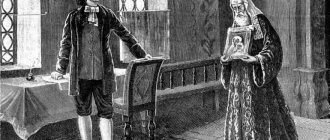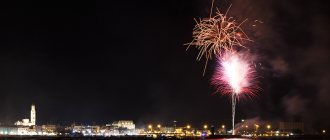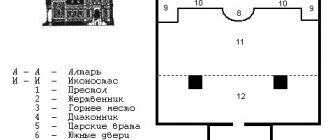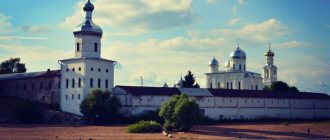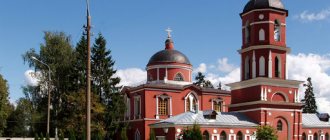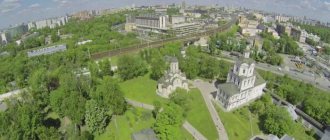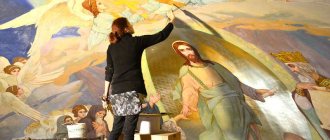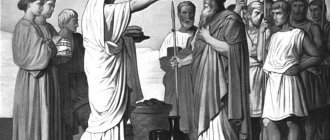Types of Orthodox churches
There were several types of church architecture in Rus'. The temple in the shape of a cross was built as a symbol of the fact that the Cross of Christ is the foundation of the church. It was thanks to him that people were freed from the power of devilish forces.
If the architecture of cathedrals and churches is presented in a circular form, this symbolizes the infinity of the existence of the Church.
When the temple is built in the form of an eight-pointed star, it represents the Star of Bethlehem, which led the Magi to where Jesus was born. The architecture of churches of this type is a symbol of the fact that human history is counted in seven long periods, and the eighth is eternity, the Kingdom of Heaven. This idea originated in Byzantium.
Often the architecture of Russian churches included buildings in the shape of ships. This is the most ancient variation of the temple. Such a building contains the idea that the temple saves believers, like a ship, from the waves of life.
In addition, the architecture of the Orthodox Church is often a mixture of these types. Religious buildings combine circular, cross and rectangular elements.
Modern church architecture in Lebanon
Located 50 km from Beirut (Lebanon), the church was designed by Parisian architect Maroun Lahoud. He had a serious task ahead of him, since the church had to promote reconciliation between the Christian community and the Druze ethno-confessional group.
After the 15-year civil war in Lebanon, many houses were destroyed. And many villagers carried the stones left over from their homes to build a new church. Therefore, we can say that it has become a symbol of the unity of the people.
Thanks to the cross-shaped openings in the walls and large windows, a lot of natural light enters the temple, which is also reflected from the snow-white walls and marble floor.
Byzantine traditions
In the East in the 5th-8th centuries, the Byzantine style in the architecture of temples and churches was popular. Byzantine traditions also extended to worship. It was here that the foundations of the Orthodox faith were born.
Religious buildings here were different, but in Orthodoxy each temple reflected a certain creed. In any church architecture, certain conditions were observed. For example, each temple remained two- or three-part. For the most part, the Byzantine style of church architecture was manifested in the rectangular shape of the buildings, figured roofing, vaulted ceilings with arches and pillars. It was reminiscent of the interior of a church in the catacombs. This style also passed into Russian church architecture, imbued with additional characteristic features.
In the middle of the dome was the Light of Jesus. Of course, the similarity of such buildings to catacombs is only general.
Sometimes churches - architectural monuments - have several domes at once. Orthodox places of worship always have crosses on their domes. By the time Orthodoxy was adopted in Rus', the cross-domed church became popular in Byzantium. He combined all the achievements in Orthodox architecture available at that time.
Nea Moni (New Monastery)
Chios Island, Greece, 1st half of the 11th century
1 / 5
Bell tower of the Nea Moni monastery Mariza Georgalou / CC BY-SA 4.0
2 / 5
General view of the monastery Bruno Sarlandie / CC BY-NC-ND 2.0
3 / 5
Mosaic “Baptism of the Lord” from the catholicon - Church of the Assumption of the Blessed Virgin Mary. 11th century Katholikon - cathedral church of the monastery.
Wikimedia Commons
4 / 5
Sectional plan of the catholicon. From the book "An Illustrated Guide to Architecture" by James Fergusson. 1855 Wikimedia Commons
5 / 5
Plan of the catholicon bisanzioit.blogspot.com
In Orthodoxy there is an important concept - the prayer of an icon or place, when the holiness of a sacred object is, as it were, multiplied by the prayers of many generations of believers. In this sense, a small monastery on a distant island is rightfully one of the most revered monasteries in Greece. It was founded in the mid-11th century by Constantine IX Monomachos Constantine IX Monomachos (1000–1055) was a Byzantine emperor from the Macedonian dynasty. in fulfillment of a vow. Constantine promised to build a church in the name of the Blessed Virgin Mary if the prophecy came true and he took the throne of the Byzantine emperor. Stavropegic status The highest status of a monastery, monastery, cathedral, making them independent of the local diocese and subordinate directly to the patriarch or Synod. The Patriarchate of Constantinople allowed the monastery to exist for several centuries in relative prosperity even after the fall of Byzantium.
The catholicon, that is, the cathedral church of the monastery, is the Church of the Assumption of the Blessed Virgin Mary. First of all, it is famous for its outstanding mosaics, but the architectural solutions also deserve close attention.
Although the outside of the temple is similar to the usual single-domed buildings in Russia, inside it is arranged differently. In the Mediterranean lands of that era, it was better felt that one of the ancestors of the domed Orthodox church (including the Church of Hagia Irene and Hagia Sophia in Constantinople) was the ancient Roman basilica. The cross is almost not expressed in plan; it is rather implied than exists in the material. The plan itself is stretched from west to east, three parts are clearly distinguishable. Firstly, the narthex, that is, the vestibule - the preliminary room. According to the Mediterranean tradition, there can be several narthexes (here they were also used as tombs), one of them opens into a semicircular exedra attached to the sides. Secondly, the main space is naos. And finally, the altar part. Here it is developed; the semicircles of the apses do not immediately adjoin the under-dome space; between them there is an additional zone - the vima. The most interesting thing can be seen in the naos. A centric building, an octaconch, is inscribed in the square formed by the outer walls. The wide dome rests on a system of hemispherical vaults, which gives the entire room a resemblance to the outstanding monuments of the times of the power of the Eastern Roman Empire - the Church of Saints Sergius and Bacchus in Constantinople and the Basilica of San Vitale in Ravenna.
Cross-domed churches in Rus'
This type of church also developed in Byzantium. Subsequently, it began to dominate - this happened in the 9th century, and then was adopted by the rest of the Orthodox states. Some of the most famous Russian churches - architectural monuments - were built in this style. These include the St. Sophia Cathedral in Kyiv, St. Sophia of Novgorod, and the Assumption Cathedral in Vladimir. They all copy the St. Sophia Cathedral in Constantinople.
For the most part, Russian architectural history is based on churches. And cross-domed structures play a leading role here. Not all variations of this style were widespread in Rus'. However, many examples of ancient buildings are of the cross-dome type.
A design of this kind transformed the very consciousness of ancient Russian people, drawing their attention to an in-depth contemplation of the universe.
Although many architectural features of Byzantine churches were preserved, churches built in Rus' from ancient times had many distinctive unique features.
Chapel by the ocean
Walking along the ocean in the resort area of Beidaihe (China), along the way you can come across the small Seashore Chapel, created by Vector Architects. It’s interesting that you can only go there during low tide, because at other times it sinks several centimeters into the water, resembling a boat rocking on the waves from afar.
Construction area of 270 sq.m. has a covered space below that hides people from the scorching sun and serves as a place to relax. On the second level there is a classic, modest chapel interior with many benches. There is a religious atmosphere here, but it is difficult to think about anything when you have a stunning view of the ocean in front of your eyes.
White stone rectangular churches in Rus'
This type is closest to the Byzantine variations. The basis of such buildings is a square, which is complemented by an altar with semicircular apses and domes on a figured roof. The spheres here are replaced by helmet-shaped coverings of domes.
In the middle of small buildings of this type there are four pillars. They serve as support for the roof. This is the personification of the evangelists, the four cardinal directions. In the center of such a building there are 12 or more pillars. They form the signs of the Cross and divide the temple into symbolic parts.
Wooden temples in Rus'
In the 15th-17th centuries, a completely unique style of constructing religious buildings appeared in Russia, which was radically different from their Byzantine counterparts.
Rectangular buildings with semicircular apses appeared. Sometimes they were white stone, and sometimes they were brick. There were walkways around the walls. The roof was figured, with domes in the shape of poppies or bulbs placed on it.
The walls were decorated with elegant decoration, windows with stone carvings and tiled trims. A bell tower was placed near the temple or above its porch.
A lot of unique features of Russian architecture appeared in the wooden architecture of Rus'. In many ways, they appeared due to the characteristics of the tree. It is quite difficult to form a smooth dome shape from boards. For this reason, in wooden churches it was replaced by a pointed tent. In addition, the entire building took on the appearance of a tent. This is how unique buildings appeared, which had no analogues in the world - churches made of wood in the shape of large pointed wooden cones. There are famous churches in the Kizhi churchyard, which are the brightest representatives of this style.
Kamppi Chapel of Silence in the center of Helsinki
Tired of the bustle of the city, you can find peace and sit in silence for a while in the chapel. It is located right in the center of Helsinki (Finland) and is open to everyone.
Kamppi Chapel with an area of 352 sq.m. designed by K2S Architects and built in 2012. The elegant wooden façade with spruce wood trim fits harmoniously into the cityscape, but is more reminiscent of an art object rather than a chapel. Indeed, the Lutheran Church of Finland has a favorable view of modern architecture. Everyone is welcome here, regardless of their religion and worldview.
Stone tented churches in Rus'
Soon the features of wooden churches influenced stone architecture. Stone tented temples appeared. The highest achievement in this style is the Intercession Cathedral in Moscow. It is known as St. Basil's Cathedral. This intricate structure dates back to the 16th century.
This is a cruciform structure. The cross is formed by four main churches, which are located around the central one - the fifth. The last one is square, while the others are octagonal.
The tent style was popular for a very short period of time. In the 17th century, the authorities prohibited the construction of such buildings. They were bothered by the fact that they were very different from ordinary ship temples. Tent architecture is unique; it has no analogues in any culture in the world.
Alexander Nevsky Cathedral
Paris, 19th century
1 / 5
Alexander Nevsky Cathedral, Paris Georges Seguin / CC BY-SA 3.0
2 / 5
Mosaic on the facade of the Alexander Nevsky Cathedral Sandrine Magrin / CC BY 2.0
3 / 5
Alexander Nevsky Cathedral, Paris Mbzt / CC BY 3.0
4 / 5
Interior of the Alexander Nevsky Cathedral Guilhem Vellut / CC BY 2.0
5 / 5
Consecration of the Alexander Nevsky Church in Paris. Illustration from the collection “Russian art sheet”. 1861 Metropolitan Museum of Art
Some churches, in addition to regular services, carry out a special mission - to worthily represent Orthodoxy in a different denominational environment. It was for this purpose that in 1856 the question of rebuilding the embassy church in Paris, previously located in the building of a former stable, was raised. Having overcome administrative difficulties and received permission from the French government (the war in Crimea, after all), construction of the building began in 1858 and was completed in 1861. It is clear that he had to become very Russian and Orthodox in spirit. However, architects Roman Kuzmin and Ivan Shtrom began designing even before the usual canons of manner a la Russe were developed. It is rather eclecticism in the full sense of the word, a mixture of styles and national traditions - however, successfully fused in a single work.
In the interior there is an obvious reference to Byzantine traditions: the central volume is adjoined by conchs (halves of domed ceilings) covered with gold-colored mosaics, as, for example, in the Church of Hagia Sophia of Constantinople. True, there are not two of them, but four - a solution proposed by the Turkish builder Mimar Sinan. The plan of the building is given the shape of an equal-armed Greek cross, whose arms are rounded on all sides thanks to the apses. Externally, the composition rather refers to the temple architecture of the times of Ivan the Terrible, when the building was made up of separate aisles-pillars, and the central part received a tent-roofed finish. At the same time, the building should not seem foreign to Parisians either: clear faceted forms, masonry made from local material, which is not entirely fair to call white stone, and, most importantly, the three-lobed outlines of the Gothic windows made the building completely at home in the capital of France.
In general, the architects managed to fuse the motley variety of styles into a single image, closest to the festive “pattern” of the 17th century, from the time of Alexei Mikhailovich.
On August 30 (September 11), 1861, in the presence of numerous guests, the building was consecrated. “Let’s say that this time the Parisians, especially the English and Italians, were unusually struck by the external, ritual form of Eastern worship, filled with greatness. <...> Everyone - both Catholics and Protestants - seemed keenly touched by the greatness of the Eastern rite, its ancient character, which inspires reverence. It was felt that this was truly a first-century Divine Service, the Divine Service of the Apostolic Men, and an involuntary disposition was born to love and honor the Church, which preserved this Divine Service with such respect” - this is how contemporaries of N.P. Barsukov perceived this event. The life and works of M.P. Pogodin. St. Petersburg, 1888–1906.. The idea was clearly a success, and the temple worthily presented the charm of Russian Orthodoxy to the West.
New stylistic forms
Russian churches were distinguished by their diversity in decoration, architecture, and decorations. Colorful glazed tiles have become especially popular. In the 17th century, Baroque elements began to dominate. Naryshkin Baroque put symmetry and completeness of multi-tiered compositions at the heart of everything.
The creations of the capital's architects of the 17th century - O. Startsev, P. Potapov, Y. Bukhvostov and a number of others - stand out. They were some harbingers of the era of Peter's reforms.
The reforms of this emperor affected, among other things, the architectural traditions of the country. The architecture of the 17th century in Russia was determined by the fashion of Western Europe. There were attempts to achieve a balance between Byzantine traditions and new stylistic forms. This was reflected in the architecture of the Trinity-Sergius Lavra, which combined ancient traditions and new trends.
During the construction of the Smolny Monastery in St. Petersburg, Rastrelli decided to reflect Orthodox traditions in the construction of monasteries. However, the organic combination did not work out. The 19th century saw a revival of interest in the architecture of the Byzantine era. It was only in the 20th century that attempts were made to return to medieval Russian architectural traditions.
Chapel of the Holy Cross in Greece
The Chapel of the Holy Cross is a timeless religious building that connects the past, present and future. It combines thousand-year-old traditions and the harmony of simplicity of modern architecture.
The creators of the unique project are specialists from OPA. Unfortunately, this concept has not yet been implemented: the search for investors continues.
But the idea is definitely worth considering. Made from simple materials, the church will be located in a rock on the island of Serifos (Greece) with beautiful views of the Aegean Sea. Thanks to the glazed facade, the church is flooded with sunlight throughout the day, and at night it serves as a bright beacon.
Church of the Intercession on the Nerl
The architecture of the Church of the Intercession on the Nerl is famous throughout the world. It is distinguished by lightness and lightness; it is a true masterpiece of the Vladimir-Suzdal architectural school. The grace manifested in the architecture of the Church of the Intercession on the Nerl became possible thanks to the ideal combination of the building with the environment - Russian nature. It is noteworthy that the temple is included in the UNESCO list of world monuments.
The building reflects the path upward, to God, and the road to it is a kind of pilgrimage. Information about the church is preserved in the Life of Andrei Bogolyubsky. It was erected in 1165, it was a memorial for the prince's son Izyaslav. He died in the war with Volga Bulgaria. According to legend, the white stones were transported here from the defeated Bulgarian principality.
It is noteworthy that descriptions of the architecture of the Church of the Intercession on the Nerl contain many comparisons of this building with a white swan floating on the water. This is the bride standing at the altar.
All that remains of the building dating back to the 12th century is a square - a skeleton with a dome. Everything else turned out to be destroyed over time. The restoration took place in the 19th century.
The descriptions of the architectural monument of the Church of the Intercession on the Nerl contain information about the verticality of the walls. But due to the measured proportions, they look inclined; due to this optical effect, the building looks taller than it actually is.
The church has a simple, no-frills interior. The frescoes were knocked off the walls during the restoration in 1877. However, there is an iconostasis with icons.
There are many wall reliefs left on the outer surface. Biblical figures, birds, animals fly by here, and there are also masks. The central figure is King David, who reads the psalms. At his side is a lion, the personification of his power. There is a dove nearby - a sign of spirituality.
Studenica (Monastery of the Assumption of the Virgin Mary)
Near Kraljevo, Serbia, 12th century
1 / 6
Eastern facade of the Church of the Assumption of the Blessed Virgin Mary in Studenica JSPhotomorgana / CC BY-SA 3.0
2 / 6
Church of the Assumption of the Blessed Virgin Mary in Studenica De kleine rode kater / CC BY-NC-ND 2.0
3 / 6
The Virgin and Child. Relief of the tympanum of the western portal Wikimedia Commons
4 / 6
Fragment of a carving on the facade of ljubar / CC BY-NC 2.0
5 / 6
Frescoes inside the temple ljubar / CC BY-NC 2.0
6 / 6
Plan of the Church of the Assumption of the Blessed Virgin Mary in Studenica archifeed.blogspot.com
Studenica is a zaduzhbina (or zadushbina): in medieval Serbia this was the name for sacred buildings built for the salvation of the soul. The monastery near the city of Kraljevo is the home of Stefan Nemanja, the founder of the Serbian state. He retired here, having taken monastic vows and renounced the throne. Stefan Nemanja was canonized and his relics were buried on the territory of the monastery.
The exact time of construction of the Church of the Assumption of the Blessed Virgin Mary in Studenica is unknown - it is only clear that it was created between 1183 and 1196. But you can clearly see how the architecture of the building reflected all the subtleties of the political situation of that time. They even talk about a separate “Rash style” (Serbia in those days was often called Raska and Rasiya).
Stefan Nemanja was both at enmity with Byzantium and oriented toward it. If you look closely at the plan of the temple, you can see that, when designing the central part, the architects clearly imitated the internal structure of the Hagia Sophia of Constantinople. This is the so-called type of weak cross, when the space under the dome opens only along the axis from the narthex to the altar. But on the side walls, even from the outside, the outlines of wide-standing arches are emphasized, on which a drum of impressive diameter is installed, providing spaciousness under the dome. Following Byzantine tastes is also noticeable in ornamental motifs - in the triforium window decorating the central apse.
At the same time, while fighting with Byzantium, essentially, in order to become its own worthy partner (in the end, the matter ended in marriage with a Byzantine princess), Nemanja actively entered into alliances with European monarchs: the Hungarian king and the Holy Roman Emperor. These contacts also influenced the appearance of Studenica. The marble cladding of the temple clearly demonstrates that its builders were well acquainted with the main trends of Western European architectural fashion. The gabled finish of the eastern façade, the arcature belts under the cornices, and the characteristic window openings with columns instead of mullions certainly make this Serbian monument similar to the Romanesque, that is, Roman style.
Church of the Ascension in Kolomenskoye
The first stone tent-type temple in Rus' is the Church of the Ascension in Kolomenskoye. Its architecture reflects the influence of the Renaissance. It was erected by Vasily III in honor of the birth of his heir, Tsar Ivan IV the Terrible.
The architectural features of the Church of the Ascension are manifested in the cruciform shape of the building, which turns into an octagon. A large tent rests on it, in turn. It overshadows the interior space of the church. It is noteworthy that there are no pillars. The temple, distinguished by its expressive silhouette, is surrounded by a gallery with staircase descents. They are executed quite solemnly.
The church has a lot of additional details that migrated here from the Renaissance. At the same time, there are many features from the Gothic. Italian bricks, the connection of the building with the centric shape of the temples of Italy give a hint that this project was created by an Italian architect who worked at the court of Vasily III. Accurate information about the author has not survived to this day, but, according to assumptions, it was Petrok Maloy. It was he who was the author of the Church of the Ascension in the Moscow Kremlin, the walls and towers of Kitay-Gorod.
St. Basil's Cathedral (Cathedral of the Intercession of the Blessed Virgin Mary, on the Moat)
Moscow, XVI century
1 / 7
St. Basil's Cathedral, Moscow Ana Paula Hirama / CC BY-SA 2.0
2 / 7
St. Basil's Cathedral, Moscow Bradjward / CC BY-NC 2.0
3 / 7
Painting on the walls of the cathedral Jack / CC BY-NC-ND 2.0
4 / 7
The Virgin and Child. Fragment of the cathedral painting Olga Pavlovsky / CC BY 2.0
5 / 7
Iconostasis of one of the altars Jack / CC BY-NC-ND 2.0
6 / 7
Fragment of the cathedral painting Olga Pavlovsky / CC BY 2.0
7 / 7
Plan of the cathedral Wikimedia Commons
Perhaps this is the most recognizable symbol of Russia. In any country, on any continent, his image can be used as a universal sign of everything Russian. And yet, in the history of Russian architecture there is no more mysterious building. It would seem that everything is known about him. And the fact that it was built by order of Ivan the Terrible in honor of the conquest of the Kazan Khanate. And the fact that construction took place between 1555 and 1561. And the fact that, according to the “Tale of the Holy Miracle-Working Velikoretsk Icon of St. Nicholas the Wonderworker about miracles from the images of St. Jonah the Metropolitan and the Reverend Father Alexander of Svir the Wonderworker” and the “Piskarevsky Chronicler”, it was built by the Russian architects Postnik and Barma. And yet it is completely unclear why this building appeared, which was unlike anything built in Rus' before.
As you know, this is not a single temple, but nine separate churches and, accordingly, nine altars established on a common basis (later there were even more of them). Most of them are votive. Before the important battles of the Kazan campaign, the tsar turned to the saint whom the church honored on that day, and promised him, in case of victory, to build a temple where the helper saint would be venerated.
Although the temple is Orthodox, in some ways it is close to its Renaissance brethren from the Catholic world. First of all, in terms of plan, this is an ideal (with a small reservation) centric composition - such were proposed by Antonio Filarete, Sebastiano Serlio and other outstanding theorists of Italian Renaissance architecture. True, the direction of the composition towards the sky and many decorative details - sharp “tongs”, for example - make it more closely related to Southern European Gothic.
However, the main thing is different. The building is decorated as never before in Moscow lands. It is also multi-colored: polychrome ceramic inserts are added to the combination of red brick and white stone carvings. And it is equipped with gold-plated metal parts - forged spirals along the edges of the tent with freely suspended metal rings between them. And it is made up of many bizarre shapes, applied so often that there is almost no simple surface of the wall left. And all this beauty is primarily directed outward. This is like a “church in reverse”; many people should not have gathered under its arches. But the space around it becomes a temple. At a minimum, Red Square acquired sacred status. Now she has become a temple, and the cathedral itself is her altar. Moreover, it can be assumed that, according to the plan of Ivan IV, the entire country was to become a sacred territory - the “Holy Russian Empire,” in the words of Tsar Kurbsky, who was then still part of the inner circle.
This was an important turn. While remaining faithful to Orthodoxy, Tsar Ivan saw it in a new way. In some ways this is close to the Renaissance aspirations of the Western world. Now it was necessary not to ignore the vanity of mortal reality in the hope of a happy existence after the end of time, but to respect the Creation given here and now, to strive to bring it to harmony and cleanse it from the filth of sin. In principle, the Kazan campaign was perceived by contemporaries not simply as an expansion of the territory of the state and the subjugation of previously hostile rulers. This was the victory of Orthodoxy and the bringing of the sacredness of the teachings of Christ to the lands of the Golden Horde.
The temple - unusually ornate (although initially crowned with more modest domes), symmetrical in plan, but triumphantly reaching towards the sky, not hidden behind the walls of the Kremlin, but placed in a place where people always crowd - became a kind of appeal from the king to his subjects, visual the image of that Orthodox Rus', which he would like to create and in the name of which he later shed so much blood.
Vladimir-Suzdal churches
Architecture flourished here during the times of Andrei Bogolyubsky and Vsevolod III. Then a church with a palace was erected here. They glorified the capital of the principality. Here stone was skillfully processed and techniques from wooden architecture were used.
In the 12th century, first-class structures made of high-quality white stone - limestone - rose here. The most ancient of them had simple decorations. The windows in the temples were narrow, they more likely resembled slits of loopholes rather than windows. The decoration of churches with stone carvings began in the 12th century. Sometimes it reflected folklore subjects, sometimes the Scythian “animal style”. The presence of Romanesque influences is also noted.
Temple in the name of the Holy Apostles Peter and Paul in Smolensk (Peter and Paul Church)
Temple in the name of the Holy Apostles Peter and Paul (Peter and Paul Church). Smolensk, 1146. Photo: Okapi Vyacheslav / photobank “Lori”
Peter and Paul Church is the oldest in Smolensk. It was built in 1146 under Prince Rostislav Mstislavich, the grandson of Vladimir Monomakh. The inside of the temple was painted with frescoes with floral patterns. Later, the brick floor was covered with majolica tiles, and the walls were decorated with tiles and panels.
During the Time of Troubles, Smolensk was occupied by the Poles, and Catholic services were held in the Peter and Paul Church. It was then that the western extension appeared - the residence of the Polish bishop. The temple was returned to Orthodox parishioners in 1654, when the Poles left the city. The diocese erected a tented bell tower near the western wall.
In the 17th–18th centuries, the third floor was built in the temple, the main nave was expanded and the floor was raised to the level of the first floor of the extension. The church acquired its original appearance only in the middle of the last century.
Today in the Peter and Paul Church you can see fragments of medieval frescoes, ancient colored tiles, as well as rare graffiti - inscriptions from the 12th century.
Read more about the temple in the name of the Holy Apostles Peter and Paul in Smolensk (Peter and Paul Church).
Smolensk-Polotsk churches
When Smolensk architecture was just developing, there were no architects here yet. Most likely, the first buildings here were erected thanks to the participation of Kiev or Chernigov residents. In Smolensk churches there are many marks on the ends of the bricks. This indicates that, most likely, Chernigov residents left their mark here.
The architecture of these cities is distinguished by its scope, which speaks in favor of the fact that in the 12th century they already had their own architects.
Smolensk architecture was popular in Rus'. Architects from here were called to many other ancient Russian lands. They also built buildings in Novgorod, which was the largest center in the country. But this rise was short-lived - it lasted 40 years. The thing is that in 1230 an epidemic broke out, after which the political situation in the city changed greatly. This was the end of the work of local architects.
Cathedral of the Twelve Apostles (Svetitskhoveli)
Mtskheta, Georgia, XI century
1 / 7
Svetitskhoveli Cathedral. Mtskheta, Georgia Viktor K. / CC BY-NC-ND 2.0
2 / 7
East façade of the Cathedral Diego Delso / CC BY-SA 4.0
3 / 7
Interior view of the cathedral Viktor K. / CC BY-NC-ND 2.0
4 / 7
Fragment of a fresco with the Last Judgment scene Wikimedia Commons
5 / 7
Fragment of a fresco with a scene of the Last Judgment Diego Delso / CC BY-SA 4.0
6 / 7
Sectional plan of the cathedral Wikimedia Commons
7 / 7
Plan of the cathedral Wikimedia Commons
The cathedral is beautiful in itself, but we must remember that it is also part of a cultural, historical and religious complex that has evolved over several centuries. The Mtkvari (Kura) and Aragvi rivers, the Jvari monastery towering above the city (built at the turn of the 6th–7th centuries), Mount Tabor with the Temple of the Transfiguration and other objects that had the same names as their Palestinian prototypes, showed in Georgia the image of the Holy Land , transferred to Iveria the sacred content of the place where the action of the New Testament story once unfolded.
Svetitskhoveli Cathedral is an outstanding monument of world architecture. However, it would be wrong to talk only about its material component, about the vaults and walls. Traditions - church and secular - are a full part of this image.
First of all, it is believed that one of the main relics of Christianity is hidden under the temple - the tunic of the Savior. It was brought from the site of the Lord's crucifixion by Jews - Rabbi Elioz and his brother Longinoz. Elioz gave the shrine to his sister Sidonia, a sincere follower of the Christian faith. The pious virgin died holding it in her hands, and even after death no force could tear the fabric from her clenched palms, so Jesus’ robe also had to be lowered into the grave. A mighty cedar tree grew over the burial site, endowing all living things around with miraculous healing properties.
When Saint Nino came to Iberia at the very beginning of the 4th century, she converted first King Miriam and then all the Georgians to the Christian faith and convinced them to build a church on the burial site of Sidonia. Seven pillars were made from cedar for the first temple; one of them, exuding myrrh, turned out to be miraculous, hence the name Svetitskhoveli - “Life-giving pillar”.
The existing building was built between 1010 and 1029. Thanks to the inscription on the facade, the name of the architect is known - Arsakidze, and the bas-relief image of a hand gave rise to another legend - however, a typical one. One version says that the delighted king ordered the master’s hand to be cut off so that he could not repeat his masterpiece.
At the beginning of the second millennium, the world was quite small, and in the architecture of the temple it is easy to notice features of the Romanesque style that was spreading throughout Europe. Externally, the composition is a cross of two three-nave basilicas under high pitched roofs with a drum under a cone in the center. However, the interior demonstrates that the structure of the temple was designed in the Byzantine tradition - Arsakidze used the cross-dome system, which is well known in Rus'.
Mountain landscapes clearly influenced the aesthetic preferences of Georgians. Unlike most Eastern Christian churches, the drums of Caucasian churches (including Armenian ones) are crowned not with round, but with sharp conical heads, prototypes of which can be found in religious buildings of Iran. The filigree decoration on the surface of the walls is due to the high level of skill of Caucasian stonemasons. Svetitskhoveli, like other pre-Mongol churches in Georgia, is characterized by a clearly legible pyramidal composition. In it, a holistic form is formed from volumes of different sizes (therefore, the apses are hidden in the general body of the temple, and only two vertical niches of the eastern facade hint at their existence).
Godunov style
Conventionally, temples in the style of Godunov classicism also stand out. These were churches built during the period when Boris Godunov (1598-1605) sat on the throne of Rus'. Then construction techniques were canonized, reflected in the symmetry and compactness of buildings.
In addition, Italian order elements have become popular. The Russian style turned out to be canonized in the Italian manner.
The variety of structures has decreased. But stylistic unity came to the fore. This manifested itself not only in Moscow, but throughout Rus'.
Patterned
The style called patterned is also noteworthy. It appeared only in the 17th century in Moscow. It is characterized by intricate shapes, decor, and complex compositions. Silhouettes in this style are incredibly picturesque. Patterning is associated with pagan roots and the late Renaissance in Italy.
For the most part, buildings in this style are represented by churches with closed vaults, without pillars and with high refectories. They have a tent covering. The interior is unusually rich in colored ornaments. There is a lot of decor inside.
Church architecture and art: from Peter I to Nicholas II
Part 1. The end of the 17th - first half of the 18th century
Saint Isaac's Cathedral
Classicism was a new direction in art, established at the state level. In church architecture, on the one hand, he demanded strict adherence to the language of forms and spatial-compositional solutions, on the other hand, he did not exclude a certain freedom of creative pursuits, which was widely used by Russian masters. This, ultimately, despite all the opposition of classicism to Russian traditions, led to the creation of majestic and uniquely beautiful monuments that enriched both Russian and world culture.
The formation of classicism in Russia began under Catherine II.
Being a pragmatic person, the empress in the first years of her reign demonstrated particular piety and reverence for church traditions. She, just like Elizaveta Petrovna, went on foot to the Holy Trinity Lavra, went to Kyiv to venerate the saints of Pechersk, fasted and received communion with all her court staff[1]. All this played a significant role in strengthening the personal authority of the empress, and “thanks to the constant tension of thought, she became an exceptional person in the Russian society of her time”[2].
Catherine II sought, following Peter I, to reshape Russian traditions according to European patterns
The architecture and art of this time were influenced by many different factors that lay essentially outside their boundaries, but led to dramatic changes - the replacement of the “Elizabethan Baroque” with classicism. First of all, it is necessary to point out Catherine’s deep hostility towards her predecessor on the throne: everything that was sweet and dear to one was not accepted and condemned by the other. The decisive reason that influenced the replacement of the general imperial baroque style with classicism was the desire of Catherine II to reshape, following in the footsteps of Peter I, Russian cultural and social traditions according to European models and patterns.
The temples founded in both capitals under Elizaveta Petrovna were completed in the Baroque style, but with the introduction into their appearance of obvious elements of the new state direction in art[3]. The Russian imperial court accepted classicism as a system of international artistic culture, within the framework of which from now on domestic culture was to exist and develop. Thus, half a century later, the initiatives and ideas of Peter I in the field of architecture and art find their real embodiment.
Catherine II
However, it should be noted that our Fatherland also originally had European cultural roots: “The ancient tradition came to Rus' through Byzantium, which had already carried out its creative implementation in the Christian spirit - rethinking”[4]. Our culture has always been part of the world, primarily European, Christian culture. A special part, but not closed, not isolated. The entire history of Russian architecture clearly demonstrates that there has never been “cultural loneliness”[5]. Each era presented contemporaries with new architectural buildings, erected using not only technical innovations[6], but also stylistic and visual elements borrowed from outside. This can be proven by Moscow monuments of the late 15th – early 16th centuries, examples of Moscow Baroque, and St. Petersburg buildings from the time of Peter I[7].
Speaking about Russian architecture, we should not forget about this. A phenomenon that has been repeatedly studied - the “traditions of Russian temple construction” - has, at the same time, such a little-studied basis: Russian architecture (and church architecture is no exception) for several centuries after the adoption of Christianity was represented by wooden architecture. This was natural due to the natural and geographical position of the country. But the tree is not only susceptible to rotting, but also unstable in the face of the elements, primarily fires that raged, sweeping away literally everything. Therefore, we should not forget that wooden architecture was developed not only on the Russian periphery. Thus, at the beginning of the 14th century, under Ivan Kalita, the Moscow Kremlin was made of wood. And even with the increasingly frequent transition (since the 10th–11th centuries) to stone in temple construction, wooden church architecture continued to exist - and not only preserved the existing construction and engineering traditions, but also created new ones, including church ones. Let us remember that in Kizhi there is a 22-domed 37-meter church, built in 1714, that is, at the height of Peter the Great’s reforms. And this is a true masterpiece of Russian national temple architecture.
It seems to us that the remark of D.S., often mentioned in the literature. Likhacheva: “Ancient Rus' is “our antiquity”” [8] - not only bright, but also deep, and it speaks of two phenomena. One, more visible (obvious) thing is the special way in which Russian culture inherited antiquity, as has already been mentioned. The second is a reminder of the deep layers of Russian culture that were once concentrated in wooden architecture. But the course of cultural development led to the fact that the movement along such an “ancient” path was interrupted[9].
For the European self-awareness of that time, the very concept of “tradition” became something archaic
During the reign of Catherine II, for the first time (even if we do not forget about Peter’s innovations), church architecture was completely under the influence of consistent state pressure aimed at reorienting to Western secular models. For the European self-awareness of that time, the very concept of “tradition” became something archaic[10]. It was the desire to consign to oblivion the philosophy of continuity of Russian tradition in architecture and art that became the main feature of the time when European classicism came to Russia.
In Europe, the return to the culture of Ancient Greece and Rome in the 18th century became a fundamentally new large-scale phenomenon that soon covered all Western countries[11]. But if for them classicism (“neoclassicism”) was nothing more than a return to their own roots in creative quests, then for Russia it became an innovation, especially in church architecture. However, we note that the foundation of the tradition has still been preserved. So, what remains is the three-part construction of the temple, inherited from Byzantium.
Latently, unconsciously, new architectural elements were intertwined with original national ones. Let us pay attention: Russian wooden temple architecture in its construction striving for vertical forms[12]. This was due to the use of the main building material - wood, logs. And such a basic architectural module as a column, so beloved by classicism, provided a visual (albeit somewhat conditional) parallel with the external elements of national wooden architecture.
Nevertheless, classicism significantly changed many things - not only in the appearance of churches, but also in the entire architectural environment.
Traditional Russian cities occupied vast areas due to extremely sparse buildings[13], which harmoniously included a natural landscape with gardens, vegetable gardens and even forests[14]. All this gave the city, with its ornate interweaving of streets, alleys and dead ends, a unique flavor[15]. At the same time, it was the temples that always acted as town-planning dominants, by which the main part of the city could be distinguished.
General redevelopment[16] of Russian cities[17], carried out in accordance with European urban planning guidelines[18], rationalized space[19]; at the same time, the existing stone temples gradually disappeared among new buildings, as a result of which they lost their dominant sound in the urban environment. As a result, the main guidelines of the socio-cultural space in which a person’s life attitudes were formed have shifted. Temples and church buildings remained, as before, as dominant architectural structures only in rural areas.
Temple construction in Moscow during the reign of Catherine II was insignificant: mainly repair work was carried out on dilapidated buildings. In St. Petersburg, construction was still underway.
Cathedral of the Life-Giving Trinity in the Holy Trinity Alexander Nevsky Lavra
Soon after the coronation, Empress Catherine II began choosing a design for the new main cathedral of the Alexander Nevsky Monastery - by that time the temple had been dismantled due to dilapidation[20]. In the Trinity Cathedral (1776–1790) of the Alexander Nevsky Lavra, the philosophical ideas of European classical buildings were embodied as fully as possible. In addition, after the consecration of the cathedral, paintings by European artists on biblical themes were placed inside it, which gave the entire interior decoration a solemn and strict, but at the same time palace look.
One of the few churches founded under Catherine II in St. Petersburg was St. Isaac's Cathedral (the third in a row). But of the elements of the new style in this cathedral, perhaps, there was only one thing - decorating the walls with marble. Such architectural ideas could not fully satisfy Catherine’s tastes, so construction moved extremely slowly: by the time Paul I ascended the throne, the temple had only been completed to the vaults.
The emergence of new church architecture in the classical style was accompanied by almost universal reconstruction - in favor of the ideas of classicism - of already existing churches. This is the first time in the history of Russian church building that something like this has happened on such a large scale. First of all, the alterations everywhere affected the roof coverings of churches, which were replaced with a simple hipped roof, which, naturally, radically changed the entire architectural sound of the buildings. Old windows were cut out and new ones were cut, the architectural decoration of the platbands was removed, additional porticoes with columns were added, the facades were decorated with monumental paintings done in oil painting on canvas. There are dozens of similar examples; Among the historically significant monuments that underwent restructuring, we will name the Assumption Cathedral of Vladimir, as well as the Trinity Cathedral, the Church of the Descent of the Holy Spirit and the Church of St. Nikon of Radonezh in the Trinity-Sergius Lavra[21]. As historian E.E. points out. Golubinsky, during the time of Catherine II, all the fortress towers of the monastery were also rebuilt in a Western style, which changed the entire appearance of the ancient monastery almost beyond recognition. Such innovations did not enrich its overall appearance; it was a striking example of the inorganic addition of structures of one time to significant architectural elements of another.
Assumption Cathedral of Vladimir
Artificial “grafting” of the ideas of classicism affected, in one way or another, almost all ancient Russian monuments. The wholesale reconstruction of churches became a demonstration of the indiscriminate and inappropriate absorption of national architectural ideas and images into the European tradition: what was original almost dissolved into oblivion, however, the new did not look at all organic or even aesthetically pleasing on ancient buildings.
The interior space of a traditional Russian church with its twilight and frescoes created conditions for prayerful repentance and sacred standing before God. And chipping away old windows and cutting through new windows created a different, rarefied air space in the interiors of ancient temples. In such a space, the fresco paintings, which consisted of large spots of color and reproduced symbols[22], the reading of which did not require examination and admiration, but called for prayerful deepening and spiritual peace, ceased to be properly perceived[23]. The ancient practice of fresco painting itself became inappropriate with a new interpretation of sacred space. Previously, frescoes filled the entire temple, consistently telling about gospel events or events in the life of the Church. The ideas of the classicist decoration of the temple implied a fundamentally different initial task. The general space of the internal walls was freed from images as much as possible. Stories on various biblical themes were presented in the form of compositions not connected into a single narrative; they were “hung as separate canvases on the walls,” and each image was mounted in a decorative pictorial frame[24].
The interiors of churches were “corrected” to suit classicism, and the relationship between paintings, natural light and liturgical rites was disrupted
In fact, the complex relationship between fresco paintings, natural light and liturgical rites was disrupted. The interiors of the temples, “corrected” to the ideas of classicism and decorated with paintings done in oil technique and sometimes, unfortunately, not of the highest artistic level[25], began to loosely resemble the hall spaces of European buildings. Today, most of the temple interiors have been restored to their original fresco paintings, which were preserved under later records[26]. Of the few that have survived to this day from that time, the paintings of the Great Cathedral of the Donskoy Monastery, completed in 1775, seem to most fully and harmoniously take into account the uniqueness of the sacred space[27]. And this is actually an isolated example.
The new churches, built in the classicist style, were characterized by clarity of composition, conciseness of volumes, perfect harmony of proportions within the classical canon, fine drawing of details, rationality and ergonomics[28]. But churches in the Byzantine traditions, which became national after centuries, largely have all the characteristic features listed above.
After the death of Empress Catherine II, her only son Pavel Petrovich ascended the throne in 1796[29]. The new emperor's policy towards the Church can be described as lenient[30]. During the Pavlovian period, there was virtually no temple construction in the capital. It is worth paying attention to this fact. By the time Paul ascended the throne, the third cathedral in the name of St. Isaac of Dalmatia had already been under construction for 28 years. Paul ordered the marble prepared for its decoration to be taken out and used in the construction of the Mikhailovsky Castle[31]. However, it was apparently indecent to completely consign the construction of the cathedral, founded by Peter I, to oblivion, and Paul ordered it to be completed as soon as possible with a minimum of funds[32], which required a change in the original plans, which is why the construction of the cathedral was again delayed, and it was consecrated only in 1802.
Cathedral in honor of the Kazan Icon of the Mother of God
The only large-scale temple-building undertaking of the reign of Paul I was the cathedral in honor of the Kazan Icon of the Mother of God in St. Petersburg: in 1800, the project of the young talented architect A.N. Voronikhin[33].
A rather unusual innovation within the framework of classicism was the church in the name of the Life-Giving Trinity (1785–1790) near St. Petersburg [34], or more precisely, its bell tower in the form of a tetrahedral pyramid, which is why the people began to call this temple “Kulich and Easter” [35]. Also unique in its artistic design is the temple-monument in honor of the Image of the Savior Not Made by Hands (1813–1823, Kazan), built already under Alexander I. This church, erected in memory of the soldiers who fell during the capture of Kazan in 1552, has the shape of a truncated pyramid, where each side is decorated with a portico[36]. However, the “non-singularity” of the given examples is evidenced by interesting architectural solutions of a later time, for example, the pyramidal St. Nicholas Church in Sevastopol (1857–1870). Thus, the essentially foreign ideas of ancient Egyptian architecture, actually alien to Russian culture, gradually acquired a new artistic meaning.
After the coup d'etat on March 12, 1801, the Russian throne was occupied by the son of Paul I, Alexander[37]. In relation to the Church, the emperor pursued basically the same policy as Catherine II. But he carried out construction on a much larger scale, including church construction, and not only in St. Petersburg, embodying new architectural ideas and projects. The ideas of classicism flourished like never before.
On August 27, 1801, Alexander I was present at the foundation stone of the Kazan Cathedral in St. Petersburg, and ten years later [38] he already prayed during the consecration of this truly unique structure, which became one of the most beautiful buildings not only in Russia, but also in Europe.
Vasily Petrovich Stasov
Of course, Russian classicism in all its manifestations was oriented toward European culture, but a political factor intervened in artistic life and weakened classicism in Russia—the Patriotic War of 1812–1814. After the Napoleonic invasion, the destruction of cities, the mockery of churches and shrines, and above all the Moscow Kremlin[39], the very image of European civilization faded and was no longer perceived by many of our ancestors with the same reverence. Political guidelines have changed - and the architecture and art of the High Empire era received a new vector of development associated with the glorification of the heroism of the Russian army, the patriotic valor of the people and the autocracy.
The series of St. Petersburg buildings of the late classicism period is completed by the construction of two churches designed by V.P. Stasov- Preobrazhensky (1825–1829)[40] and Troitsky (1828–1835)[41]. Both of these church buildings were founded under new socio-political conditions and significantly changed tastes. In these churches, the author seemed to be trying to give a new interpretation to the forms and philosophical ideas of classicism through a return to the traditional Russian five-domed structure.
Stasov tried to combine classicism with tradition: porticos and columns with Russian five-domed architecture
According to the established opinion, the construction of St. Isaac's Cathedral according to the design of A. Montferrand (1817–1858; already the fourth in a row) actually ends the era of classicism in Russia[42]. The author was faced with the same problem that V.P. tried to solve. Stasov: to embody the traditional Russian five-domed structure in a building that is classical in spirit. For St. Isaac's Cathedral, majestic multi-figure bronze reliefs, sculptures, unique entrance doors, and columns were made. All these works are creations of the best masters. St. Isaac's Cathedral is an expression of the official understanding of Orthodoxy at that time[43].
As for the Mother See, in the first quarter of the 19th century, church building in Moscow was insignificant, which is understandable: according to the state commission, in Moscow in 1812, 6,496 houses out of 9,151 and 122 churches out of 329 were destroyed [44]. Large-scale construction and restoration work began immediately after liberation from Napoleonic troops[45].
Project of the Cathedral of Christ the Savior on Sparrow Hills, architect A. Vitberg
A special place in Moscow architecture was to be occupied by the impressive building of the Cathedral of Christ the Savior on Sparrow Hills, erected in honor of the victory over the French[46]. In its architectural design it was a traditional building in the classicist style. However, in 1826, the construction of the temple, which began in 1817, was stopped by decree of Emperor Nicholas I: for nine years, not even the foundation was built, although a lot of money was spent. They never returned to the idea of building on Vorobyovy Gory.
It is important to emphasize that following classical models in the church architecture of the ancient Russian capital had certain specifics: “Moscow architecture of mature classicism was characterized, in comparison with St. Petersburg, by greater softness and warmth in the interpretation of classical forms”[47].
In general, the Alexander era in culture is characterized by serious internal contradictions. During this period, there was a kind of collision of two directions - the ongoing classicism and the emerging Russian Renaissance. The heterogeneity of ideas, styles, and searches, in our opinion, is one of the characteristic features of the architecture and fine arts of Russia at this time.
As we see, classicism in Russia went through all stages of its development: from a restrained early “invasion” into traditional temple buildings, when it was intertwined with “Elizabethan Baroque,” to establishing itself with an almost declarative rejection of any non-classical images, after which its gradual decline began , which manifested itself primarily in the church architecture of the province, where it turned into increasingly mediocre and uniform forms[48]. Classicism, transformed at a later time into the Empire style, was aimed at glorifying the state power of the victorious country.
Despite all the contradictions in the process of adapting the ideas of classicism to, so to speak, “Russian conditions,” there were—and this must be emphasized—some positive aspects. Russian masters, having mastered the ideological, artistic, technical and engineering fundamentals and techniques of classical architecture in the shortest possible time, created examples equal to their European counterparts, which significantly advanced Russian art, including church art, forward. And such magnificent churches as Kazan and St. Isaac’s have become truly world masterpieces. And it is quite appropriate to talk about the era of classicism in Russia as “Russian classicism” - a unique and inimitable phenomenon of world culture as a whole.
(The ending follows.)
Totem style
Baroque, which manifested itself most clearly in St. Petersburg, was also reflected in the buildings of the Russian north. In particular, in the city near Vologda - Totma. The uniqueness of the architecture of his buildings led to the emergence of the “Totem Baroque”. This style appeared in the 18th century; already in the next century there were at least 30 temples built in this style. But in the same century, many of them were rebuilt. At the moment, they are mostly destroyed or remain in disrepair. The features of this style were adopted during the sea voyages of local merchants. They were the customers of these churches.
Ustyug style
Some of the earliest religious buildings in Veliky Ustyug were buildings dating back to the 17th century. It was at that moment that the foundations of stone architecture began to appear here. The architectural style of this area flourished in the 17th century. Construction continued on its features for just over 100 years. During this time, many local architects appeared in Veliky Ustyug, who were distinguished by their great talent and unprecedented skill. They left behind many unique churches. At first, five-domed churches with side chapels were common. And in the 18th century, temples with a longitudinal axis gained popularity.
Smolny Cathedral in St. Petersburg
Author: Bartolomeo Francesco Rastrelli
Architectural style: Elizabethan Baroque
Date of construction: 1748-1835
Where is: St. Petersburg, Rastrelli Square, 1
Current use: active temple.
The magnificent Smolny Cathedral began to be built by order of Empress Elizabeth Petrovna. According to legend, she wanted to abdicate the throne in favor of her nephew and heir to the throne, Peter Fedorovich, and retire to a monastery. The project of the monastery was entrusted to the architect Rastrelli and in 1748 construction of the cathedral began on an unprecedented scale. In 1756, the Seven Years' War began and construction was suspended. Elizabeth died, Rastrelli left Russia, and the almost finished cathedral was forgotten.
But then Nicholas I decided to complete the construction of the temple and in 1835 it was finally completely built. Rastrelli's grandiose plan was not fully realized: a huge bell tower 140 meters high, which was supposed to become the architectural dominant of the monastery, was not built, and many decorative details and interiors were also not completed. Despite this, the heavenly-colored Smolny Cathedral with graceful domes is a stunningly beautiful and unique architectural design of the great Rastrelli.
